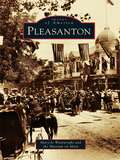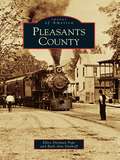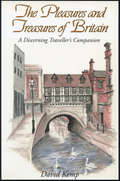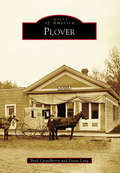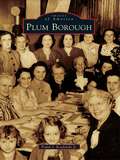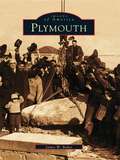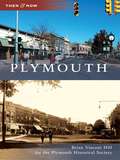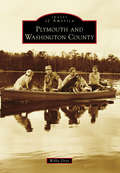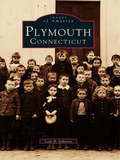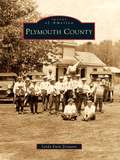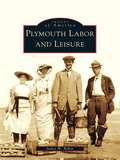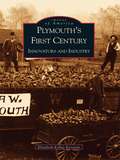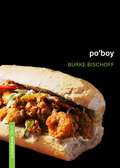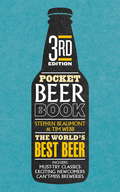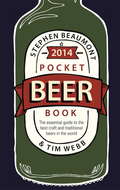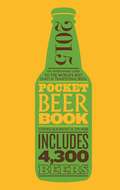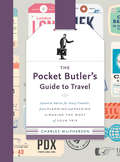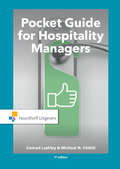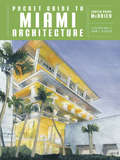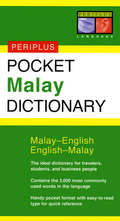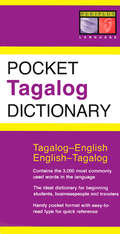- Table View
- List View
Pleasanton
by Museum On Main Mary-Jo WainwrightThe city of Pleasanton, located in the beautiful Amador-Livermore valley, was formed in 1867 when immigrants John Kottinger and Joshua Neal used land from their Californio wives' dowries and laid out a town. Kottinger named the city after Civil War general Alfred Pleasonton, but a postal clerical error changed the spelling to "Pleasanton" and the name stuck. The men secured Pleasanton's future by offering land to the Western Pacific Railroad for a railroad station and landing. Planning for future growth thus became a legacy that is still embraced by this modern city of 70,000 people. Today families and tourists are attracted to Pleasanton's historic downtown, where 19thcentury buildings still stand and people stroll among its many shops and restaurants.
Pleasants County
by Ellen Pope Ruth Ann DayhoffFormed from portions of Wood, Tyler, and Ritchie Counties, Pleasants County was founded in 1851 and was named after Gov. James Pleasants Jr. of Virginia. Residents of Pleasants County fondly recall many of the buildings that no longer exist today, such as the button factory, blacksmith shop, marble factory, and the Quaker State Oil Refinery, all of which are preserved in the photographs that are showcased throughout Images of America: Pleasants County. Taking a step back in time, these photographs illustrate how the town and county looked more than 100 years ago, exploring a variety of the county's activities and historic scenes and offering a colorful insight into the past as well as the present.
The Pleasures and Treasures of Britain
by David KempIs a famous queen of Britain really bured beneath platform 10 at King’s Cross station in London? What is the telephone number of the National Theatre? what is the best place to eat in Worcester? Where is the National Bagpipe Museum? (Hint: not in Scotland) Was Pointius Pilate born in Pitlochry? The answers to these questions and literally thousands more are to be found in David Kemp’s fascinating guidebook, The Pleasures and Treasures of Britain. Nowhere else will the discerning traveller find so much diverse and essential information about British culture gathered together in one volume. With the author as your witty and knowledgeable guide, take a tour through nearly fifty cities, from Penzance to Perth, from London to Cardiff and Belfast. Each city section begins with a concise, readable history and a guided walk around the town, planned to take in as many of the significant local sights as can comfortably be included. Next are exhaustive listings, including telephone numbers and addresses, of everything a culturally curious visitor might want to seek out: theatre, art galleries, museums, antique markets, antiquarian and other bookstores, restaurants, lcoal fairs and festivals and more. Finally, under the headings of Artistic Associations and Ephemera, each section concludes with an entertaining collection of local lore, gossip, legend and anecdote.
Plover (Images of America)
by Diane Lang Brad CasselberryNestled on the Yellow Banks of the Wisconsin River, Plover was originally used by Native Americans for portaging between the Wisconsin and Wolf Rivers. After being established as the Portage County seat in 1844, the area grew rapidly. Soon, mills sprang up, farmers worked the land, businesses flourished, and lodging could not be built fast enough to keep up with the demand. By 1857, Plover boasted 500 residents and 112 buildings, with 40 more under construction. In 1868, the county seat was moved out of Plover, and by the mid-1880s, Plover had begun to decline. Despite this, and the fact that the village has been dissolved twice, incorporated three separate times, and gone by four different names, Plover has proved resilient. Since being reincorporated in 1971, Plover has thrived and grown at an impressive rate. Today, the main businesses are part of the industrial, agricultural, and retail sectors.
Plum Borough (Images of America)
by Frank J. Kordalski Jr.Plum Township, which later reorganized as Plum Borough, was founded on December 18, 1788, and westward pioneers soon chose to settle in the region. William McJunkin, an Irish emigrant and one of the earliest settlers, came to Plum Borough and in 1790 was granted a tract of land he came to call "Greenfield." In the 19th century, Plum Borough was an agricultural gold mine for the brave settlers who wished to emigrate from their East Coast homesteads. During the 20th century, Plum Borough emerged from being an agricultural suburb of the Steel City to become a vibrant residential community with a wondrously bright future.
Plymouth (Images of America)
by James W. BakerPlymouth is best known as the Pilgrim landing place, but history did not stop when the dishes were cleared away from the first Thanksgiving. A prosperous fishing village before the War of 1812, Plymouth developed mills and factories to line its modest brooks during the Industrial Revolution, and elegant dwellings were built to replace humble Colonial homes. Steamboats and the railway brought waves of immigrants and summer visitors, transforming the small Yankee village into a bustling town. Later, the mills closed, tourist traffic replaced the clatter of machinery, and massive housing developments transformed the town as the kaleidoscope of history turned yet again. Plymouth's intriguing past is not altogether lost. In Plymouth, the reader will find the elm-shaded streets, mill villages, modest shops, and rustic pond-side cottages that generations of residents and visitors have loved. The reader will see vanished landmarks, such as the Samoset House and the Mayflower Inn, the Cornish and Burton schools, and the Leyden Street Casino. From the world's largest rope manufactory (Plymouth Cordage) to Uncle George's famous woolly horse, from Water Street's ancient wharves and chandleries to the storm of 1898, and from Pres. Warren G. Harding's tercentenary visit to Richard Nixon's welcome of the Mayflower II in 1957, the best of the town's visual history is gathered in Plymouth.
Plymouth (Then and Now)
by Brian Vincent Hill Plymouth Historical SocietyAs the home to Native American encounters, rugged pioneers, governors, state legislators, founders of political parties, landmark legal decisions, multimillionaires, scandals, patents, and the largest international business of its kind, Plymouth has certainly received its 15 minutes of fame. Yet most citizens of Plymouth today only know it as a wonderful community full of parks, subdivisions, and a quaint Norman Rockwell-like downtown.
Plymouth and Washington County (Images of America)
by Willie DryePlymouth and Washington County, North Carolina, are entwined with the beginnings of American history. The area surrounding the Albemarle Sound was the birthplace of North Carolina. Plymouth began as a 17th-century trading post on the Roanoke River, which empties into the sound. When the nearby Dismal Swamp Canal opened in 1805, Plymouth was linked to the deepwater harbor of Norfolk, Virginia, and quickly grew into one of North Carolina's busiest ports. With the outbreak of the Civil War in 1861, young men from Washington County enlisted in both the Union and Confederate armies, and Plymouth was the scene of fierce fighting throughout the conflict. Today, Plymouth and Washington County attract visitors eager to enjoy boating, bass fishing, and bird-watching in an unspoiled coastal wilderness; visit Civil War sites; or absorb the fascinating maritime history.
Plymouth, Connecticut (Images of America)
by Lani B. JohnsonDuring the seventeenth and eighteenth centuries, the town of Plymouth, Connecticut--formerly known as Northbury--was settled only by scattered groups of Indians and hearty newcomers from Europe. As time went on, however, the Town of Plymouth developed into an industrial community composed of nine organized districts: Plymouth, Greystone, Allentown, the Lakes, Pequabuck, Terryville, East Plymouth, and the Holt District. Residents of Plymouth were industrious and inventive from the very beginning. In 1793 Eli Terry founded the clock-making business that became the foremost enterprise in the town's history, and in 1854 the expansion of the Eagle Lock Company fostered the development of Terryville. During the course of the nineteenth century, a plethora of smaller companies developed along the town's many waterways, manufacturing everything from furniture to toys, plows, and hats. Plymouth, Connecticut chronicles the development of the town through the years with a remarkable series of vintage images and informative text.
Plymouth County (Images of America)
by Linda Ewin ZiemannPlymouth County is one of the largest counties in Iowa, claiming 864 square miles. The early pioneers made this observation: "If you stared long enough at the open prairie, it would stare back at you!" The first white settlers arrived in 1856 and began establishing the communities of Westfield and Melbourne that same year. The town of Le Mars was founded in 1869. The town name was derived from the first initials of five women who visited the site with a railroad official. The early pioneers endured hardships and disappointments. They were committed to a way of life, forging ahead to make a better life for themselves, their children, and their grandchildren. Plymouth County portrays an overview of the county's history in early photographs.
Plymouth Labor and Leisure (Images of America)
by James W. BakerPlymouth is best known as the destination of the Mayflower. The Pilgrims, their heirs, and more recent immigrants spent their lives here as farmers, fishermen, shopkeepers, and factory workers. Industries such as the Plymouth Cordage Company, Puritan Mills, Mabbett's, and Russell Mills built communities that are in danger of being forgotten today. Plymouth Labor and Leisure revisits the industrial history of this town through images of Plymouth's people at work in the mills and in corner grocery stores, visiting downtown shops, and attending neighborhood schools.
Plymouth's First Century: Innovators and Industry (Images of America)
by Elizabeth Kelley KerstensThe year 2002 marks the 175th anniversary of the founding of Plymouth Township in Michigan Territory. The first settlers were true pioneers, carving a living out of the wilderness and working together to establish a community. Farms and farmers were the backbone of the community until after the Civil War when two railroads intersected in the Village of Plymouth. The railroads brought many opportunities to the area, and helped spread the products invented by an innovative population.Plymouth, Michigan's First Century: Innovators and Industry contains more than 200 images from the Plymouth Historical Museum and from the collections of some of Plymouth's current residents. You'll see the township blossom from farms and mills to a cohesive community of inventors and patriots. Early images of the main business block of Plymouth Village are reminiscent of the Wild West; later images depict a vibrant community, as it remains today.
Po’Boy (Louisiana True)
by Burke BischoffPo’Boy tells the story of how a humble sandwich became a symbol of New Orleans culture, history, and cuisine. Invented to help feed a crowd of out-of-work individuals in New Orleans’s streetcar industry, the po’boy is a submarine-like sandwich served on French bread, with common fillings that include fried seafood, roast beef and gravy (“debris”), and hot sausage. Rich with historical detail, Po’Boy welcomes readers into the world of the city’s most iconic sandwich.
Pocket Beer 3rd edition: The indispensable guide to the world's beers
by Stephen Beaumont Tim WebbWith so many beers now on offer, it's more essential than ever to have an expert guide - this carefully curated selection encompasses the very best beer the world has to offer.Written by two of the world's leading beer experts, with the help of a team of international contributors, The Pocket Beer Book takes you from the Bock beers of Germany to the Trappist beers of Belgium, the complex bitters and stouts of Britain to the cutting-edge brews of North America. This expert selection covers the extraordinary variety the world's beers now have to offer.Detailed tasting notes cover the top traditional, classic and new craft beers of over 80 countries. With special features on national beer styles and the best new Breweries to Watch as well as Iconic Breweries of both traditional and craft brewing, this up-to-the-minute guide is indispensable for any beer lover.
Pocket Beer 3rd edition: The indispensable guide to the world's beers
by Tim Webb Stephen BeaumontWith so many beers now on offer, it's more essential than ever to have an expert guide - this carefully curated selection encompasses the very best beer the world has to offer.Written by two of the world's leading beer experts, with the help of a team of international contributors, The Pocket Beer Book takes you from the Bock beers of Germany to the Trappist beers of Belgium, the complex bitters and stouts of Britain to the cutting-edge brews of North America. This expert selection covers the extraordinary variety the world's beers now have to offer.Detailed tasting notes cover the top traditional, classic and new craft beers of over 80 countries. With special features on national beer styles and the best new Breweries to Watch as well as Iconic Breweries of both traditional and craft brewing, this up-to-the-minute guide is indispensable for any beer lover.
Pocket Beer Book 2014
by Stephen Beaumont Tim WebbAs featured in beer-loving Great Food Magazine, this landmark guide provides beer fans with easy access to an expert overview and puts a world of superb beers at your disposal. Written by two of the world's leading beer experts, with the help of a team of international contributors, The Pocket Guide to Beer 2014 takes you from the Bock beers of Germany to the Trappist beers of Belgium, the complex bitters and stouts of Britain to the cutting-edge brews of North America. This expert selection covers the extraordinary variety the world's beers now have to offer. Tasting notes, organised by country, provide succinct commentary on the chosen beers and cover the brewery and each beer's key characteristics. With over 3,000 beers covered, this book encompasses more familiar established beers as well as exciting new discoveries from the myriad craft breweries that are emerging around the world, covering over 60 countries.Punctuating the tasting notes is information on 'beer destinations', specific places where you can best experience a beer in situ. An extensive introductory chapter to the book also covers styles of beer and emerging trends.Contents Includes:How to Use This Book IntroductionWhat is Craft Beer? Beer Styles Beer at the TableEUROPE NORTH AMERICA & THE CARIBBEAN LATIN AMERICA ASIA & THE MIDDLE EASTAUSTRALASIAAFRICA And More!
Pocket Beer Book, 2nd edition: The indispensable guide to the world's best craft & traditional beers - includes 4,300 beers
by Stephen Beaumont Tim WebbAs featured in beer-loving Great Food Magazine, this landmark guide provides beer fans with easy access to an expert overview and puts a world of superb beers at your disposal. Written by two of the world's leading beer experts, with the help of a team of international contributors, The Pocket Beer Book 2015 takes you from the Bock beers of Germany to the Trappist beers of Belgium, the complex bitters and stouts of Britain to the cutting-edge brews of North America. This expert selection covers the extraordinary variety the world's beers now have to offer.Tasting notes, organised by country, provide succinct commentary on the chosen beers and cover the brewery and each beer's key characteristics. With 4,300 beers featured, this book encompasses more familiar established beers as well as exciting new discoveries from the myriad craft breweries that are emerging around the world, covering 80 countries.Punctuating the tasting notes is information on 'beer destinations', specific places where you can best experience a beer in situ. An extensive introductory chapter to the book also covers styles of beer and food and beer pairings.
The Pocket Butler's Guide to Travel: Essential Advice for Every Traveller, from Planning and Packing to Making the Most of Your Trip (Pocket Butler)
by Charles MacPhersonIndispensable travel advice from Everyone's Favourite ButlerA world authority on the art of travel, Charles MacPherson has planned itineraries for celebrities and business leaders, and trained the staff of some of the world's leading hotels. In this easy-to-follow guide, you will find his tips on how to: * Plan Your Trip: choose luggage and accommodations, master wrinkle-free packing, secure an upgrade and manage your schedule. * Travel in Style: for business or pleasure; by plane, train, cruise ship, coach, yacht, car or even private jet. * Make the Most of Your Stay: get help from the concierge (every hotel's best-kept secret) and navigate international dining etiquette and tipping culture. And much more! Slip this compact book into your carry-on luggage for a trusted companion wherever your travels may take you.<
Pocket Guide for Hospitality Managers
by Conrad Lashley Michael N. ChibiliA concise, practical guide that provides the skills and knowledge for current and future managers across the hospitality industry. The book provide a concise resource for all emerging hospitality managers, and for academics preparing students for careers within the hospitality industry.With a ‘how to do’ agenda, the authors offer a practical guide to the skills and knowledge needed by those who will be managing bars, restaurants and hotels in the fast moving hospitality retailing contexts. Written in a non-academic style, this book will be a valuable resource for students and early career managers working in the hospitality sector.
Pocket Guide to Miami Architecture (Norton Pocket Guides)
by John F. Desalvo Judith Paine McbrienThis guidebook organizes 100 architectural highlights into walkable tours in downtown Miami and Miami Beach. From the tropical vernacular of the Barnacle House to the Art Deco neighborhoods of Miami Beach, from the Midcentury Modernism of Morris Lapidus to the sophisticated rhythms of Arquitectonica, Judith Paine McBrien captures the vibrancy and diversity of architecture in Miami and its environs. Set in a stunning seaside site, the buildings of Miami, Miami Beach, Coral Gables, and Coconut Grove tell a fascinating story of artifice, innovation, charm, and international influence. This masterfully illustrated guide highlights the buildings that visitors will want to see, among them the City Beautiful planning of Coral Gables; the classical glory of Vizcaya; and the New World Symphony, Frank Gehry's twenty-first-century reinterpretation of the music hall.
Pocket Malay Dictionary
by Zuraidah OmarThis is a pocket sized Malay DictionaryIntended for use by tourists, students, and business people traveling to Malaysia Pocket Malay Dictionary is an essential tool for communicating in Malay. It features all the essential Malay vocabulary appropriate for beginning to intermediate students. It's handy pocket format and easy-to read type will make any future trip to Malaysia much easier. In addition to being an excellent English to Malay dictionary and Malay to English dictionary Pocket Malay Dictionary contains important notes on the Malay language, Malay grammar and Malay pronunciation. All Malay words are written in English and Malay script (Rumi) so that in the case of difficulties the book can simply be shown to the person the user is trying to communicate with.This dictionary contains:The 3,000 most commonly used words in the Malay languageEnglish and Romanized Malay (Rumi)An introduction to and history of the Malay languageInformation on Malay grammarA guide to pronouncing Malay correctlyOther books from this bestselling series you might enjoy are: Pocket Vietnamese Dictionary, Pocket Cambodian Dictionary, Pocket Thai Dictionary, Pocket Indonesian Dictionary, Pocket Mandarin Chinese Dictionary, and Pocket Cantonese Dictionary.
Pocket Malay Dictionary
by Zuraidah OmarThis is a pocket sized Malay DictionaryIntended for use by tourists, students, and business people traveling to Malaysia Pocket Malay Dictionary is an essential tool for communicating in Malay. It features all the essential Malay vocabulary appropriate for beginning to intermediate students. It's handy pocket format and easy-to read type will make any future trip to Malaysia much easier. In addition to being an excellent English to Malay dictionary and Malay to English dictionary Pocket Malay Dictionary contains important notes on the Malay language, Malay grammar and Malay pronunciation. All Malay words are written in English and Malay script (Rumi) so that in the case of difficulties the book can simply be shown to the person the user is trying to communicate with.This dictionary contains:The 3,000 most commonly used words in the Malay languageEnglish and Romanized Malay (Rumi)An introduction to and history of the Malay languageInformation on Malay grammarA guide to pronouncing Malay correctlyOther books from this bestselling series you might enjoy are: Pocket Vietnamese Dictionary, Pocket Cambodian Dictionary, Pocket Thai Dictionary, Pocket Indonesian Dictionary, Pocket Mandarin Chinese Dictionary, and Pocket Cantonese Dictionary.
Pocket Malay Dictionary
by Zuraidah OmarThis is a pocket sized Malay DictionaryIntended for use by tourists, students, and business people traveling to Malaysia Pocket Malay Dictionary is an essential tool for communicating in Malay. It features all the essential Malay vocabulary appropriate for beginning to intermediate students. It's handy pocket format and easy-to read type will make any future trip to Malaysia much easier. In addition to being an excellent English to Malay dictionary and Malay to English dictionary Pocket Malay Dictionary contains important notes on the Malay language, Malay grammar and Malay pronunciation. All Malay words are written in English and Malay script (Rumi) so that in the case of difficulties the book can simply be shown to the person the user is trying to communicate with.This dictionary contains:The 3,000 most commonly used words in the Malay languageEnglish and Romanized Malay (Rumi)An introduction to and history of the Malay languageInformation on Malay grammarA guide to pronouncing Malay correctlyOther books from this bestselling series you might enjoy are: Pocket Vietnamese Dictionary, Pocket Cambodian Dictionary, Pocket Thai Dictionary, Pocket Indonesian Dictionary, Pocket Mandarin Chinese Dictionary, and Pocket Cantonese Dictionary.
Pocket Tagalog Dictionary
by Renato PerdonThis is a pocket sized Tagalog (Filipino) DictionaryIntended for use by tourists, students, and business people traveling to The Philippines Pocket Tagalog Dictionary is an essential tool for communicating in Tagalog. It features all the essential Tagalog vocabulary appropriate for beginning to intermediate students. It's handy pocket format and easy-to read type will make any future trip to The Philippines much easier. In addition to being an excellent English to Tagalog dictionary and Tagalog to English dictionary Pocket Tagalog Dictionary contains important notes on the Tagalog language, Tagalog grammar and Tagalog pronunciation. All Filipino words are written in English and Tagalog so that in the case of difficulties the book can simply be shown to the person the user is trying to communicate with.This dictionary contains:The 3,000 most commonly used words in the Tagalog languageAn introduction to and history of the Tagalog languageInformation on Tagalog grammarA guide to pronouncing Tagalog correctlyOther books from this bestselling series you might enjoy are: Pocket Vietnamese Dictionary, Pocket Cambodian Dictionary, Pocket Thai Dictionary, Pocket Indonesian Dictionary, and Pocket Malay Dictionary.
Pocket Tagalog Dictionary
by Renato PerdonThis is a pocket sized Tagalog (Filipino) DictionaryIntended for use by tourists, students, and business people traveling to The Philippines Pocket Tagalog Dictionary is an essential tool for communicating in Tagalog. It features all the essential Tagalog vocabulary appropriate for beginning to intermediate students. It's handy pocket format and easy-to read type will make any future trip to The Philippines much easier. In addition to being an excellent English to Tagalog dictionary and Tagalog to English dictionary Pocket Tagalog Dictionary contains important notes on the Tagalog language, Tagalog grammar and Tagalog pronunciation. All Filipino words are written in English and Tagalog so that in the case of difficulties the book can simply be shown to the person the user is trying to communicate with.This dictionary contains:The 3,000 most commonly used words in the Tagalog languageAn introduction to and history of the Tagalog languageInformation on Tagalog grammarA guide to pronouncing Tagalog correctlyOther books from this bestselling series you might enjoy are: Pocket Vietnamese Dictionary, Pocket Cambodian Dictionary, Pocket Thai Dictionary, Pocket Indonesian Dictionary, and Pocket Malay Dictionary.
